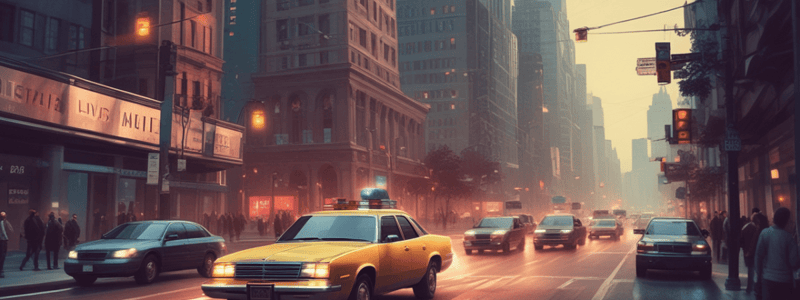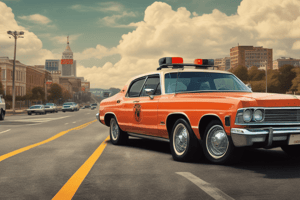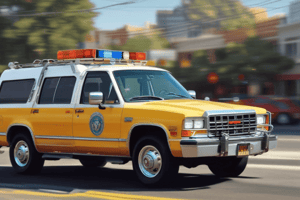Podcast
Questions and Answers
What is the primary goal of this lesson plan?
What is the primary goal of this lesson plan?
- To outline the importance of following traffic signals
- To emphasize the consequences of reckless driving
- To explain the importance of speeding laws
- To introduce various traffic regulations and vehicle equipment regulations (correct)
What is the objective of demonstrating how to locate specific information regarding traffic regulations?
What is the objective of demonstrating how to locate specific information regarding traffic regulations?
- To familiarize trainees with RSMo Chapters 304 and 307 (correct)
- To introduce the concept of traffic control devices
- To highlight the consequences of violating traffic regulations
- To emphasize the importance of following traffic rules
What is a common element of Careless and Imprudent Driving?
What is a common element of Careless and Imprudent Driving?
- Driving with improper vehicle equipment
- Failure to stop at a stop sign
- Disregarding traffic control devices (correct)
- Following too closely
Under what circumstances can an emergency vehicle operator disregard the rules of the road?
Under what circumstances can an emergency vehicle operator disregard the rules of the road?
Who is responsible for clearing injurious substances from the highway?
Who is responsible for clearing injurious substances from the highway?
What is a requirement for operating as an emergency vehicle?
What is a requirement for operating as an emergency vehicle?
What is a common vehicle equipment regulation?
What is a common vehicle equipment regulation?
In what circumstances can peace officers tow vehicles from highways and private property?
In what circumstances can peace officers tow vehicles from highways and private property?
What is the purpose of reviewing the organization of the Revised Statutes of Missouri?
What is the purpose of reviewing the organization of the Revised Statutes of Missouri?
What is the classification of exceeding the posted speed limit by 20 mph or more?
What is the classification of exceeding the posted speed limit by 20 mph or more?
What is the purpose of having recruits find specific information regarding traffic regulations and equipment regulations?
What is the purpose of having recruits find specific information regarding traffic regulations and equipment regulations?
What is the main difference between RSMo 304.010 and RSMo 304.130?
What is the main difference between RSMo 304.010 and RSMo 304.130?
What is the description of the violation when a person operates a motor vehicle in a careless and imprudent manner?
What is the description of the violation when a person operates a motor vehicle in a careless and imprudent manner?
What is the purpose of having recruits discuss specific traffic or equipment regulations with the class?
What is the purpose of having recruits discuss specific traffic or equipment regulations with the class?
What is the classification of exceeding the posted speed limit by 11-15 mph?
What is the classification of exceeding the posted speed limit by 11-15 mph?
What is the purpose of reviewing the Table of Contents, Chapters, and Sections of the Revised Statutes of Missouri?
What is the purpose of reviewing the Table of Contents, Chapters, and Sections of the Revised Statutes of Missouri?
What is the main difference between a misdemeanor and an infraction?
What is the main difference between a misdemeanor and an infraction?
What is the purpose of having recruits locate specific information regarding traffic regulations and equipment regulations?
What is the purpose of having recruits locate specific information regarding traffic regulations and equipment regulations?
What is a key consideration for an emergency vehicle operator?
What is a key consideration for an emergency vehicle operator?
What is considered impeding the flow of traffic?
What is considered impeding the flow of traffic?
What is the general rule for following distance?
What is the general rule for following distance?
What type of vehicles must come to a full stop at railroad crossings?
What type of vehicles must come to a full stop at railroad crossings?
Where can a school bus driver not take on or discharge students?
Where can a school bus driver not take on or discharge students?
What must a driver do when approaching a school bus that is loading or unloading students?
What must a driver do when approaching a school bus that is loading or unloading students?
What does a flashing red light indicate?
What does a flashing red light indicate?
What is the purpose of a stop sign?
What is the purpose of a stop sign?
What determines a stop at an intersection?
What determines a stop at an intersection?
What should a driver do after stopping at a stop sign?
What should a driver do after stopping at a stop sign?
What should a driver do when facing a flashing red signal?
What should a driver do when facing a flashing red signal?
Where are U-turns prohibited?
Where are U-turns prohibited?
When can a driver drive on the left side of the roadway?
When can a driver drive on the left side of the roadway?
What is required of emergency vehicles?
What is required of emergency vehicles?
What should other drivers do when an emergency vehicle is approaching?
What should other drivers do when an emergency vehicle is approaching?
Who is authorized to tow vehicles from highways and private property?
Who is authorized to tow vehicles from highways and private property?
Under what circumstances can a law enforcement officer authorize a towing operator to remove a vehicle?
Under what circumstances can a law enforcement officer authorize a towing operator to remove a vehicle?
Who is responsible for tow charges?
Who is responsible for tow charges?
When can a driver cross a median or drive to the left side of a barrier?
When can a driver cross a median or drive to the left side of a barrier?
What is the purpose of the rules governing emergency vehicles?
What is the purpose of the rules governing emergency vehicles?
Who is responsible for immediately clearing injurious substances from a roadway?
Who is responsible for immediately clearing injurious substances from a roadway?
What is a requirement for vehicles carrying material or farm products on public highways?
What is a requirement for vehicles carrying material or farm products on public highways?
What is the purpose of auxiliary lamps on a vehicle?
What is the purpose of auxiliary lamps on a vehicle?
When are lighted lamps required on vehicles?
When are lighted lamps required on vehicles?
How many headlamps must a motorcycle be equipped with?
How many headlamps must a motorcycle be equipped with?
What is the maximum height above the level on which the vehicle stands that the high-intensity portion of the light from a single-beam headlamp can project?
What is the maximum height above the level on which the vehicle stands that the high-intensity portion of the light from a single-beam headlamp can project?
What is the minimum distance ahead that a single-beam headlamp must be able to reveal persons and vehicles?
What is the minimum distance ahead that a single-beam headlamp must be able to reveal persons and vehicles?
What is the arrangement of headlamps or auxiliary lamps on motor vehicles other than motorcycles or motor driven cycles?
What is the arrangement of headlamps or auxiliary lamps on motor vehicles other than motorcycles or motor driven cycles?
What is the penalty for violating the single-beam headlamp intensity regulations?
What is the penalty for violating the single-beam headlamp intensity regulations?
What is the purpose of the statute regarding loads to be secured on motor vehicles and trailers?
What is the purpose of the statute regarding loads to be secured on motor vehicles and trailers?
At what distance ahead must a motor vehicle's headlights reveal persons and vehicles?
At what distance ahead must a motor vehicle's headlights reveal persons and vehicles?
How many rear lamps must a motor vehicle have?
How many rear lamps must a motor vehicle have?
What is the maximum height, including load, for a vehicle operating on non-designated highways?
What is the maximum height, including load, for a vehicle operating on non-designated highways?
When must a motor vehicle operator dim their headlamps?
When must a motor vehicle operator dim their headlamps?
What is the maximum width, including load, for a vehicle operating on a highway?
What is the maximum width, including load, for a vehicle operating on a highway?
When being towed, how far apart must the two vehicles be?
When being towed, how far apart must the two vehicles be?
What is the purpose of a red reflector on a motorcycle?
What is the purpose of a red reflector on a motorcycle?
What is the minimum height above the ground for a taillamp?
What is the minimum height above the ground for a taillamp?
What is the purpose of a white light on a tail lamp?
What is the purpose of a white light on a tail lamp?
How many red reflectors must a motor drawn vehicle have?
How many red reflectors must a motor drawn vehicle have?
What is the maximum length of a single motor vehicle operated on the highways of this state?
What is the maximum length of a single motor vehicle operated on the highways of this state?
What is the purpose of a safety bumper on a bus?
What is the purpose of a safety bumper on a bus?
When are studded tires prohibited on Missouri highways?
When are studded tires prohibited on Missouri highways?
What is prohibited on windshields, sidewings, and windows of motor vehicles?
What is prohibited on windshields, sidewings, and windows of motor vehicles?
Who is exempt from wearing a seatbelt while operating a passenger car?
Who is exempt from wearing a seatbelt while operating a passenger car?
What is a 'child booster seat' as defined in RSMo 307.179?
What is a 'child booster seat' as defined in RSMo 307.179?
What is the maximum combined length of a truck-tractor and semi-trailer?
What is the maximum combined length of a truck-tractor and semi-trailer?
When is a driver of a motor vehicle transporting a child required to secure the child in a properly adjusted and fastened safety belt?
When is a driver of a motor vehicle transporting a child required to secure the child in a properly adjusted and fastened safety belt?
What is the purpose of a child passenger restraint system as defined in RSMo 307.179?
What is the purpose of a child passenger restraint system as defined in RSMo 307.179?
What is the term for a motor vehicle designed to carry 10 persons or less, excluding motorcycles and motorized bicycles?
What is the term for a motor vehicle designed to carry 10 persons or less, excluding motorcycles and motorized bicycles?
How old must a child be to be secured by a vehicle safety belt or booster seat?
How old must a child be to be secured by a vehicle safety belt or booster seat?
What is the penalty for violating subdivision (l), (2), or (3) of subsection 2 of this section?
What is the penalty for violating subdivision (l), (2), or (3) of subsection 2 of this section?
Who is exempt from the provisions of this section?
Who is exempt from the provisions of this section?
What is the minimum age of a child who must be secured in a child passenger restraint system?
What is the minimum age of a child who must be secured in a child passenger restraint system?
What is the purpose of the highways and transportation commission's program?
What is the purpose of the highways and transportation commission's program?
Under what circumstances can a child be transported in the back seat of a motor vehicle while wearing only a lap belt?
Under what circumstances can a child be transported in the back seat of a motor vehicle while wearing only a lap belt?
What is the requirement for children weighing less than forty pounds?
What is the requirement for children weighing less than forty pounds?
What is the requirement for children at least four years of age but less than eight years of age, who also weigh at least forty pounds but less than eighty pounds, and who are also less than four feet, nine inches tall?
What is the requirement for children at least four years of age but less than eight years of age, who also weigh at least forty pounds but less than eighty pounds, and who are also less than four feet, nine inches tall?
What is the penalty for violating subdivision (4) of subsection 2 of this section?
What is the penalty for violating subdivision (4) of subsection 2 of this section?
What happens if a driver receives a citation for violating subdivision (l), (2), or (3) of subsection 2 of this section?
What happens if a driver receives a citation for violating subdivision (l), (2), or (3) of subsection 2 of this section?
Flashcards are hidden until you start studying
Study Notes
Traffic Law and Traffic Regulations
- This lesson covers the elements of common moving and equipment violations, traffic regulations, and vehicle equipment regulations outlined in RSMo Chapters 304 and 307.
Objectives
- Identify the elements of traffic regulations, including speeding, careless and imprudent driving, impeding the flow of traffic, following too closely, failure to stop at railroad crossings, and more.
- Identify the requirements of operating as an emergency vehicle and the circumstances under which an emergency vehicle operator may disregard the rules of the road.
- Identify the circumstances that give peace officers the authority to tow vehicles from highways and private property.
- Identify who is responsible for clearing injurious substances from the highway.
Traffic Regulations
- Exceeded posted speed limit:
- Various laws for different speed limits (1-5 mph, 6-10 mph, 11-15 mph, 16-19 mph, 20 mph or more)
- Careless and imprudent driving:
- Endangering the property, life, or limb of another person
- Failure to maintain control of the vehicle due to excessive speed
- Impeding the flow of traffic:
- Driving at a slow speed that blocks the normal flow of traffic
- Following too closely:
- Driving more closely than reasonably safe and prudent
- Leaving less than one car length of space for every 10 mph
- Failure to stop at railroad crossings:
- Certain vehicles must come to a full stop within 50 feet of the crossing
Emergency Vehicles
- Law enforcement, fire, ambulance, public utility, towing, and government vehicles used in an emergency
- Required to have at least one lighted lamp visible from 500 feet
- Must give an audible signal by siren, bell, or whistle
- The driver must believe an actual emergency exists to operate as an emergency vehicle
- Authorized to operate with emergency lights and sirens only when responding to an emergency
Towing Vehicles
- Law enforcement can tow vehicles from highways and private property under certain circumstances
- Vehicles left unattended on public property for more than 48 hours
- Abandoned property illegally left on a highway or bridge
- Stolen vehicles
- Vehicles left on private property without the owner's consent
Equipment Regulations
- Loads must be secured to prevent debris on the highway
- Headlamps and taillamps must be in good working condition
- Dimming of headlamps is required when approaching oncoming traffic or when behind another vehicle
- Rear projection of objects must be marked with a red light or flag### Vehicle Safety and Regulations
- Every towed vehicle must be coupled to the towing vehicle by a safety chain, cable, or equivalent device in addition to the primary coupling device, except if the primary coupling device is a center-locking ball located over or nearly over the rear axle and not supported by the rear bumper of the towing vehicle.
Vehicle Dimensions and Weight
- Maximum width: 96 inches, excluding clearance lights, rearview mirrors, and additional accessories required by federal, state, or city law or regulation.
- Exception: Vehicles with a maximum width of 102 inches may travel on interstate highways and designated highways, plus a distance of up to 10 miles from such highways.
- Maximum height: 13 feet 6 inches, except for vehicles operating only on the interstate highway system or designated routes with a maximum height of 14 feet.
- Maximum length: 40 feet for single motor vehicles, 45 feet for buses equipped with safety bumpers, and 60 feet for truck-tractors and semi-trailers, except as permitted by RSMo 304.170 (5).
Tires and Safety Features
- Studded tires are prohibited between April 1 and November 1.
- Vision-reducing material is prohibited on windshields and windows, except with a physician's prescription for individuals with certain physical disorders.
- Seatbelts are required for passenger cars, with exemptions for cars manufactured before January 1, 1968, and for certain drivers and passengers under specific conditions.
Child Restraints and Safety
- Children under 16 years old must be restrained in a child passenger restraint system or booster seat, depending on their age, weight, and height.
- Specific requirements apply for children under 4 years old, 4-8 years old, and over 8 years old or weighing over 80 pounds.
- Exemptions apply for certain family situations, school buses, and public carriers for hire.
Motorized Bicycles and Scooters
- Operation of motorized bicycles, pocket bikes, and scooters is regulated, with licensing requirements and prohibitions on interstate highways.
Studying That Suits You
Use AI to generate personalized quizzes and flashcards to suit your learning preferences.



